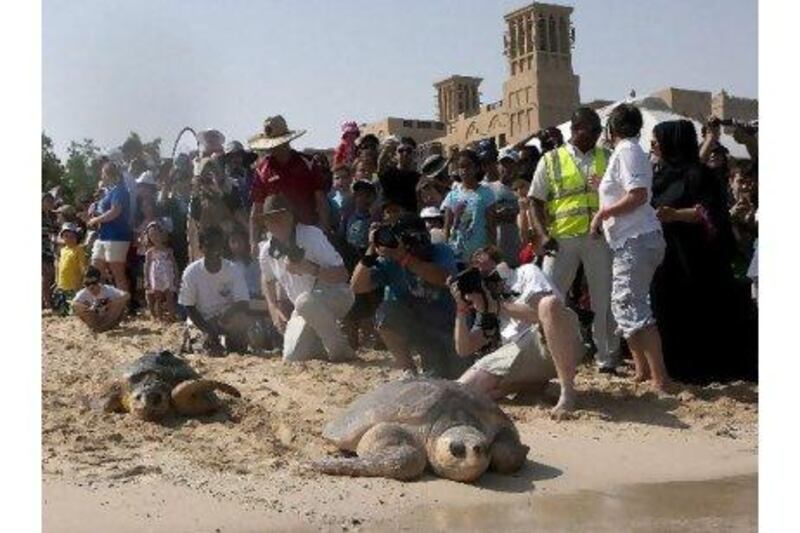DUBAI // Six sea turtles released back into the wild in front of 1,500 cheering spectators at Jumeirah Beach in June are providing vital insights into the behaviour and life cycles of the animals.
The two loggerheads, two hawksbills and two green turtles had been rescued by the rehabilitation team at the Burj Al Arab hotel and nursed back to health after being found sick or injured.
A third green turtle freed at the same time died after being washed ashore near Sir Bani Yas Island in Abu Dhabi, with severe injuries caused by an accident at sea.
But the rest are going strong, and satellite transmitters attached to their backs are sending scientists a stream of valuable data.
The study is unique because it is the first time that two of each species have been released at the same time in the region, making it possible to compare their behaviour.
It had been thought that the turtles might escape the high summer temperatures in the Arabian Gulf and head for the Arabian Sea, but all six have stayed put.
"They're all still within the Gulf," said Warren Baverstock, aquarium operations manager at the Burj Al Arab. "None of them has ventured out to where the water's cooler, which we thought at least one or two of them might.
"With our new satellite tags we have the ability to record temperatures. So when the turtles come to the surface they're sending us not just their location but also the temperature of the water they've been in for the past three or four days.
"Releasing two of each has given a clear indication of what each species likes to do during the hottest months of the year."
The maximum depth of the Arabian Gulf is 90 metres, and the deeper waters stay cool all year round. The cooler the temperatures the satellite tags record, the deeper the turtles have been venturing.
The loggerheads are the champion divers, descending to levels that were between 21°C and 24°C at a time when surface temperatures were between 36°C and 39°C.
The green turtles seem to be the most tolerant of high temperatures, staying closer to the surface.
"The loggerheads go right into the middle of the Gulf and go very, very deep where the temperatures are a lot cooler," said Mr Baverstock.
"We're monitoring this temperature data and we're building a massive picture about three main species of turtle within this region.
"All the tags are giving really good, strong signals, so we're hoping that we'll have data for another 12 months so we can find out what they do in the winter months."
The largest animal released was a loggerhead weighing 100 kilograms, which is thought to be between 60 and 80 years old.
Rescued turtles are rehabilitated in tanks in the basement of the Burj Al Arab, and so far this year 350 have received intensive care.
Current patients include one turtle with a buoyancy problem that prevents it from swimming properly, and a smaller animal that was found with fishing line tangled around a flipper. If the line had not been removed it would have eventually severed the flipper as the turtle grew.
Schoolchildren released yearlings that had been saved by the rehabilitation team at the June event.
Andrew Jacob, 10, from the Delhi Private School in Sharjah, freed a hawksbill yearling.
"My turtle will be remembered so dearly as it has made me realise that I too can help by promoting awareness," Andrew said. "It has made me feel special, a feeling different from any other incident so far in my life."
News of the released turtles can be found at facebook.com/turtle.rehabilitation, while the latest data obtained from the satellite tags is available at seaturtle.org





